Unit 8 It must belong to Carla. Section B (2a~2e) 课件+嵌入音视频(共45张PPT) 2024-2025学年人教版英语九年级全一册
文档属性
| 名称 | Unit 8 It must belong to Carla. Section B (2a~2e) 课件+嵌入音视频(共45张PPT) 2024-2025学年人教版英语九年级全一册 |  | |
| 格式 | pptx | ||
| 文件大小 | 36.0MB | ||
| 资源类型 | 教案 | ||
| 版本资源 | 人教新目标(Go for it)版 | ||
| 科目 | 英语 | ||
| 更新时间 | 2024-07-21 22:10:55 | ||
图片预览


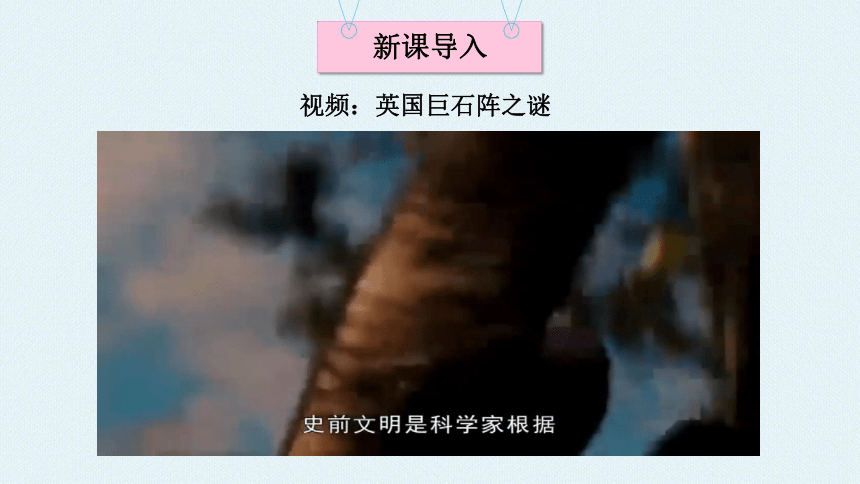
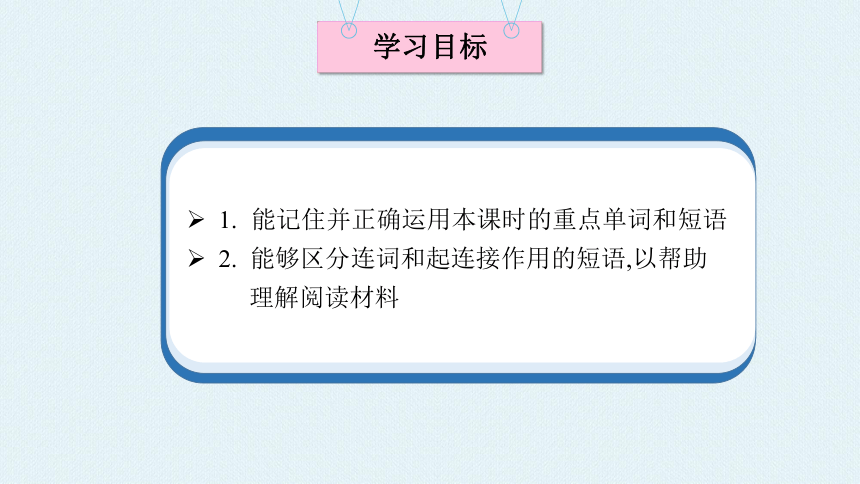



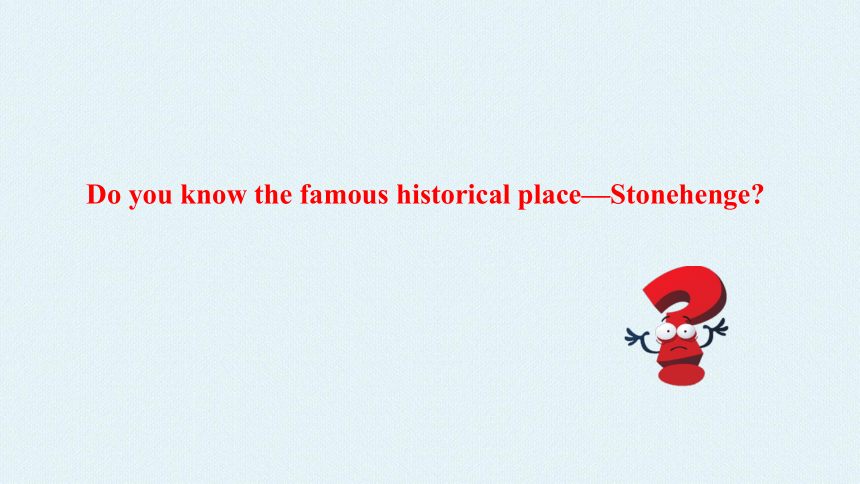

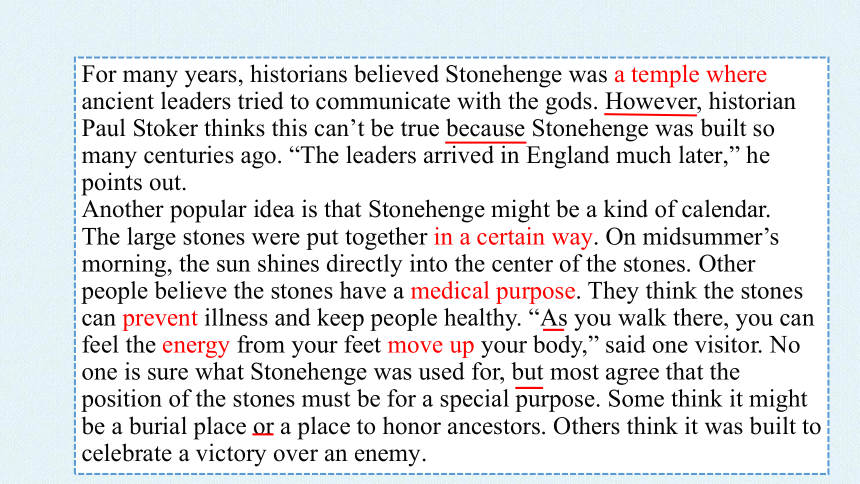
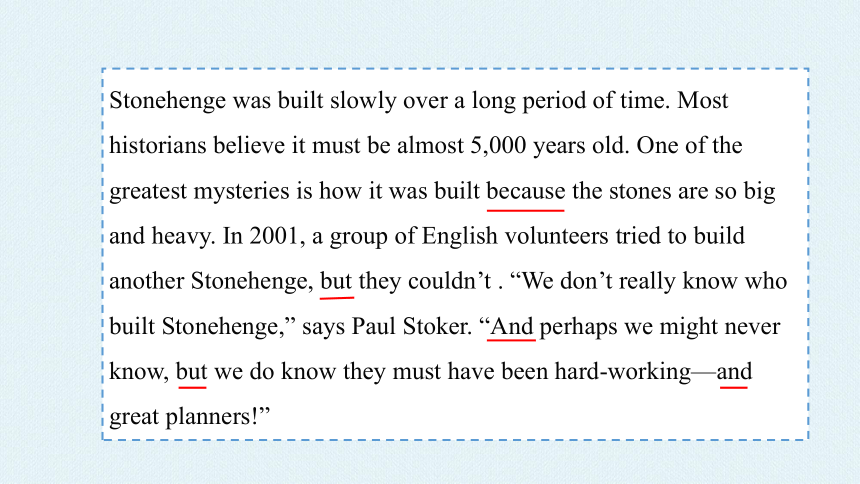
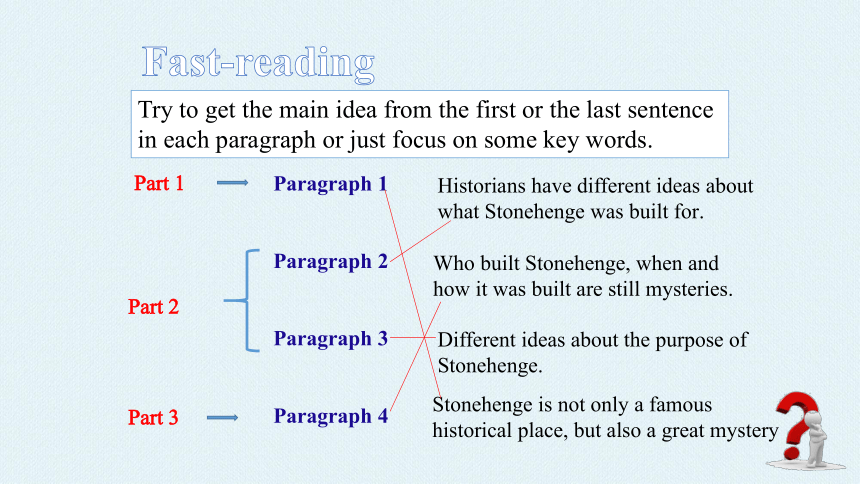
文档简介
(共45张PPT)
Unit 8
It must belong to Carla.
Section B (2a~2e)
1.学习目标
3.重点探究
2.自主学习
学习导航
5.当堂检测
6.课堂总结
4.拓展提升
新课导入
视频:英国巨石阵之谜
学习目标
1. 能记住并正确运用本课时的重点单词和短语
2. 能够区分连词和起连接作用的短语,以帮助
理解阅读材料
自主学习
单词
短语
重点
express, circle, Britain, receive, leader, medical, purpose, prevent, energy, position, victory, enemy, period.
学习连词的应用
并利用关联词帮助理解文章的含义。
at the same time, one of …, see the sun rising, point out, in a certain way, shine directly into, prevent ... from ..., move up
express v. 表示;表达 circle n. 圆圈 v. 圈出
Britain 大不列颠 receive v. 接待;收到
leader n. 领导;领袖 medical adj. 医疗的
purpose n. 目的;目标 prevent v. 阻止;阻挠
energy n. 力量;精力 position n. 位置;地方
victory n. 胜利;成功 enemy n. 敌人;仇人
period n. 一段时间 ;时期
at the same time 同时;一起
one of+形容词最高级+可数名词复数
最……之一
see the sun rising 看见太阳正在升起
point out 指出
in a certain way 用某种方式
shine directly into 直射入
prevent ... from ... 阻止……做……
move up向上移
自主学习
连词是一种连接词与词、短语与短语以及句与句的虚词,它不能独立担任句子成分而只起连接作用。
What is the linking word
Can you remember some linking words or phrases we have learned
so: 表示前因后果
because, since, as: 表示原因
but, however, though: 表示意义转折
not only … but also: 表示递进意义
or: 表示选择关系
when, while: 表示两个动作同时进行
重点探究
2a Match each linking word or phrase with its purpose.
Linking word or phrase Purpose of linking word or phrase
so expressing a difference
as, because, since giving a choice
but, however, though expressing a result
not only... but also expressing two things happening at the same time
or giving reasons
when, while adding information
Do you know the famous historical place—Stonehenge
2b Read the article below and underline the linking
words and phrases. Do you think you have made
correct matches in 2a
Stonehenge, a rock circle, is not only one of Britain’s most famous historical places but also one of its greatest mysteries. Every year it receives more than 750,000 visitors. People like to go to this place especially in June as they want to see the sun rising on the longest day of the year.
Stonehenge—Can Anyone Explain Why It Is There
IDENTIFYING LINKING LANGUAGE
Identifying conjunctions or phrases that link ideas together will help you understand what you read.
For many years, historians believed Stonehenge was a temple where ancient leaders tried to communicate with the gods. However, historian Paul Stoker thinks this can’t be true because Stonehenge was built so many centuries ago. “The leaders arrived in England much later,” he points out.
Another popular idea is that Stonehenge might be a kind of calendar.
The large stones were put together in a certain way. On midsummer’s morning, the sun shines directly into the center of the stones. Other people believe the stones have a medical purpose. They think the stones can prevent illness and keep people healthy. “As you walk there, you can feel the energy from your feet move up your body,” said one visitor. No one is sure what Stonehenge was used for, but most agree that the position of the stones must be for a special purpose. Some think it might be a burial place or a place to honor ancestors. Others think it was built to celebrate a victory over an enemy.
Stonehenge was built slowly over a long period of time. Most historians believe it must be almost 5,000 years old. One of the greatest mysteries is how it was built because the stones are so big and heavy. In 2001, a group of English volunteers tried to build another Stonehenge, but they couldn’t . “We don’t really know who built Stonehenge,” says Paul Stoker. “And perhaps we might never know, but we do know they must have been hard-working—and great planners!”
Fast-reading
Try to get the main idea from the first or the last sentence
in each paragraph or just focus on some key words.
Paragraph 1
Paragraph 2
Paragraph 3
Paragraph 4
Stonehenge is not only a famous historical place, but also a great mystery
Historians have different ideas about what Stonehenge was built for.
Different ideas about the purpose of Stonehenge.
Who built Stonehenge, when and how it was built are still mysteries.
Part 1
Part 3
Part 2
Careful-reading
Part 1 (Para. 1)
1. What is Stonehenge
2. How many visitors does it receive every year
3. When do people like to go to Stonehenge Why
Stonehenge, a round circle, is not only one of Britain’s most famous historical places but also one of its greatest mysteries.
It receives more than 750,000 visitors.
In June. Because they want to see the sun rising
on the longest day of the year.
Part 2 (Para 2 and 3)
Mysteries about Stonehenge What might Stonehenge have been used as/for as/for
as a temple for ancient leaders to communicate with the gods
as a kind of calendar
for preventing illness and keeping people healthy
as a burial place or a place to honor ancestors
for celebrating a victory over an enemy
Read carefully and underline the key words while reading. Focus on the new words and guess the meanings according to the context.
Careful-reading
Part 3 (Para 4)
Mysteries about Stonehenge When was it built
How was it built
Who built it
It must be almost 5000 years old.
In 2001, a group of English volunteers tried to build another Stonehenge, but they couldn’t.
Perhaps we might never know, but they have been hard-working and great planners.
Careful-reading
2c Read the article and complete the chart.
Mysteries about Stonehenge What Stonehenge might have been used for ...
Who built it
How was it built
What was it used for
as a temple
a kind of calendar
have a medical purpose
might be a burial place
celebrate a victory over an enemy
2d Complete the sentences using the words from
the chart in 2a on page 62.
Midsummer day is in June ______ a lot of people go to Stonehenge during this month.
2. The sun shines straight into the center of Stonehenge ____________ the stones were put in a special position.
so
because
3. Some people think the rocks can _________ stop people from becoming ill _________ can keep them healthy.
4. We don’t know who built Stonehenge _____ how it was built.
5. Historians think Stonehenge was built about 5,000 years ago; _________ they are not sure.
not only
or
however
but also
2e Can you think of any other mysteries, either in China
or another part of the world, that are similar to Stonehenge
What do you know about these mysteries What is mysterious
about them Discuss them with your group.
Group work
环游世界 看看十大诡异地域
1、位于英格兰威尔特郡索尔兹伯里平原的巨石阵
又称环状列石、太阳神庙等名,是欧洲著名的文化神庙遗址。据推测约出现于公元前4000——2000年,有学者认为是史前文明遗址,也有人认为是外星文明的痕迹。
2、中国阿尔泰山荒原通天石人之谜
被疑为人类对外星文明的记录,矗立在
草原上的石人成为一种神秘主义的象征。
3、古埃及金字塔
金字塔的神秘至今仍是一个谜,不少学者认为金字塔是古代外星人留下的建筑物。
4、玛雅文明
在玛雅人的编年史中,曾记载了地球
9000万年至4亿年之间的事。
5.巴别通天塔
巴比伦是一座令人神往的古城,它位于幼发拉底河和底格里斯河的交汇处。
6.南美火地岛:浮出地面的骷髅头
7.斯堪的纳维亚半岛峡湾:
狮身人面守护者
8.南斯拉夫境内:熟睡的老猫
9.加拿大与美国阿拉斯加交接处:
磅礴奔腾的巨大象龟
10. 极光:贞子降临
11. 南美秘鲁:富兰克林头像
12. 新西兰南岛:不可思议的太极图
拓展提升
Language points
1. expressing a difference 表达不同之处
express作动词,意为“表示;表达(思想和感情) ”。express … to sb.意为“对某人表达……”。
e.g. I find it difficult to express my meaning.
我发觉难以表达我的意思。
express的名词形式为expression,意为“表达方式;表示;表情”。
e.g. I sent them flowers as an expression of thanks.
我送给他们鲜花以表示感谢。
2. Stonehenge, a rock circle, is not only one of Britain’s most
famous historical places but also one of its greatest mysteries.
巨石阵,一个岩石圈,不仅是英国最著名的历史遗迹之一,
而且是英国最神秘的事物之一。
(1) circle 可数名词,意为 “圆圈”,也可表示具有共同兴趣
爱好或职业等的 “阶层;圈子;界”。
e.g. The children stood in a circle around the fire.
孩子们围着火站成一圈。
circle 可用作动词,表示“圈出”。
e.g. Please circle the correct answers. 请圈出正确的答案。
(2) not only … but also …意为 “不但……而且……”
在运用时要遵循以下三个原则:
①并列原则: not only … but also …并列连词,连接两个并列
成分,其中also可以省略。
②主谓一致原则: not only … but also …连接两个并列主语时,
谓语动词在人称和数上要与but also 的主语保持一致。
③倒装原则:not only … but also …连接两个并列分句时,
not only置于句首,表示强调,其引导的句子要用部分倒装,
即把谓语动词的一部分(如情态动词、助动词等)放在主语的
前面,而but also后的句子用正常语序。
e.g. Not only he but also I am interested in pop music.
不仅是他而且我也对流行音乐感兴趣。
3. Every year it receives more than 750,000 visitors.
每年它会接待超过75万的参观者。
receive 及物动词,此句中意为 “接待;招待”。 receive 还可以表示 “接到;收到”, 与get 同义,其后可接介词 from。
e.g. They are very glad to have the opportunity to receive the guest.
他们对有机会接待这位贵宾感到非常高兴。
e.g. I received a letter from my mother. 我收到母亲的一封来信。
e.g. I received his invitation to the party yesterday, but I refused to accept it. 昨天我收到了他的晚会请柬,但我拒绝接受。
receive "收到",强调客观上收到这一事实,不表明是否愿意接受
accept “接受”, 主动地或自愿地接受,带有“满意;同意;认可”等意味,其反义词为refuse
receive
(客观上)收到
accept
(主观上)接受
4. For many years, historians believed Stonehenge was a temple where ancient leaders tried to communicate with the gods. 多年以来,历史学家们认为巨石阵是古代首领试图和神灵沟通的一座神庙。
此句中的where ancient leaders tried to communicate with the gods是由关系副词where引导的一个定语从句,修饰temple。
e.g. This is the hospital where I was born.
我就是我出生的那家医院。
5. The large stones were put together in a certain way.
这些巨大的石头以某种方式被放置在一起。
in a certain way表示“以某种方式”,其中certain表示“某一;某个;某些”的意思,用于名词之前。
e.g. The doctor is only at this hospital on certain days.
那位医生只有在某些日子才在这所医院。
6. Other people believe the stones have a medical purpose.
另一些人认为石头有医疗效果。
(1) medical形容词,意为“医疗的;医学的”, 其名词形式
是medicine。
e.g. He is a medical student. 他是个医科学生。
(2) purpose 名词,意为“目的;目标,意图”,常与of 连用。
常见短语 on purpose, 意为“故意地”
e.g. What was the purpose of his visit 他来访的目的是什么?
e.g. She did it on purpose, of course. 她当然是故意那样做的。
7. They think the stones can prevent illness and keep people healthy.
他们认为这些石头可以预防疾病并使人保持健康。
prevent 动词,意为“阻止;阻挠”,相当于stop。
常用结构 prevent sb. (from) doing sth. 意为“阻止某人做某事”。
e.g. Could you prevent these accidents 人们能阻止这些事故发生吗?
e.g. Mother prevents/stops me (from) eating too many candies.
妈妈不让我吃太多糖果。
【注意】from 在主动语态中可以省略,但在被动语态中不得省略。
e.g. He was prevented/stopped from playing computer games.
他被禁止玩电脑游戏。
8. As you walk there, you can feel the energy from your feet move up your body … 当你走到那儿,你能感觉到(一股)能量从你的双脚上升到你的身体里……
energy 意为"精力;力量",其形容词形式为energetic,意为“精力充沛的”。
e.g. Young people usually have more energy than the old.
年轻人通常比老年人更有活力。
e.g. He is an energetic boy. 他是个精力充沛的男孩。
当堂检测
Ⅰ. 根据句意或提示写出正确的单词或短语。
1. The young are full of ________. They are ________(energy).
2. You can feel the energy from your feet ________(向上) your body.
3. The suns ________(direct) into the center of the stones.
4. __________(history) believed the Great Wall is one of the greatest
mysteries.
5. The trees prevent the wind from ________(move) to the west.
directly
energy
energetic
move up
Historians
moving
Ⅱ. 按要求完成下列各句,每空一词。
1. 他们想要在一年中时间最长的那天看见太阳升起。
They want to see the sun _____ ____ the ______ day of the year.
2. 巨大的石头以某种方式被放在一起。
Huge stones______ _____ together ____ a certain way.
3. 石头的位置一定是为了一种特别的目的。
The ________ of the stones _____ be for a _______ ________.
4. 你能感觉到能量从你的脚底向上移到你的全身。
You can feel the energy ______ your feet ______ ____ your body.
on
longest
were
in
rising
put
position
must
special
from
move
purpose
up
课堂总结
重要短语:
not only … but also …意为 “不但……而且……”
express … to sb.意为“对某人表达……”。
on purpose 故意地
in a certain way表示“以某种方式”
重要单词:
express,表示;表达
circle , 圆圈”
receive 及物动词,此句中意为 “接待;招待”
medical形容词,意为“医疗的;医学的”
prevent 动词,意为“阻止;阻挠”
energy 意为"精力;力量",其形容词形式为energetic
Unit 8
Section B (2a~2e)
Unit 8
It must belong to Carla.
Section B (2a~2e)
1.学习目标
3.重点探究
2.自主学习
学习导航
5.当堂检测
6.课堂总结
4.拓展提升
新课导入
视频:英国巨石阵之谜
学习目标
1. 能记住并正确运用本课时的重点单词和短语
2. 能够区分连词和起连接作用的短语,以帮助
理解阅读材料
自主学习
单词
短语
重点
express, circle, Britain, receive, leader, medical, purpose, prevent, energy, position, victory, enemy, period.
学习连词的应用
并利用关联词帮助理解文章的含义。
at the same time, one of …, see the sun rising, point out, in a certain way, shine directly into, prevent ... from ..., move up
express v. 表示;表达 circle n. 圆圈 v. 圈出
Britain 大不列颠 receive v. 接待;收到
leader n. 领导;领袖 medical adj. 医疗的
purpose n. 目的;目标 prevent v. 阻止;阻挠
energy n. 力量;精力 position n. 位置;地方
victory n. 胜利;成功 enemy n. 敌人;仇人
period n. 一段时间 ;时期
at the same time 同时;一起
one of+形容词最高级+可数名词复数
最……之一
see the sun rising 看见太阳正在升起
point out 指出
in a certain way 用某种方式
shine directly into 直射入
prevent ... from ... 阻止……做……
move up向上移
自主学习
连词是一种连接词与词、短语与短语以及句与句的虚词,它不能独立担任句子成分而只起连接作用。
What is the linking word
Can you remember some linking words or phrases we have learned
so: 表示前因后果
because, since, as: 表示原因
but, however, though: 表示意义转折
not only … but also: 表示递进意义
or: 表示选择关系
when, while: 表示两个动作同时进行
重点探究
2a Match each linking word or phrase with its purpose.
Linking word or phrase Purpose of linking word or phrase
so expressing a difference
as, because, since giving a choice
but, however, though expressing a result
not only... but also expressing two things happening at the same time
or giving reasons
when, while adding information
Do you know the famous historical place—Stonehenge
2b Read the article below and underline the linking
words and phrases. Do you think you have made
correct matches in 2a
Stonehenge, a rock circle, is not only one of Britain’s most famous historical places but also one of its greatest mysteries. Every year it receives more than 750,000 visitors. People like to go to this place especially in June as they want to see the sun rising on the longest day of the year.
Stonehenge—Can Anyone Explain Why It Is There
IDENTIFYING LINKING LANGUAGE
Identifying conjunctions or phrases that link ideas together will help you understand what you read.
For many years, historians believed Stonehenge was a temple where ancient leaders tried to communicate with the gods. However, historian Paul Stoker thinks this can’t be true because Stonehenge was built so many centuries ago. “The leaders arrived in England much later,” he points out.
Another popular idea is that Stonehenge might be a kind of calendar.
The large stones were put together in a certain way. On midsummer’s morning, the sun shines directly into the center of the stones. Other people believe the stones have a medical purpose. They think the stones can prevent illness and keep people healthy. “As you walk there, you can feel the energy from your feet move up your body,” said one visitor. No one is sure what Stonehenge was used for, but most agree that the position of the stones must be for a special purpose. Some think it might be a burial place or a place to honor ancestors. Others think it was built to celebrate a victory over an enemy.
Stonehenge was built slowly over a long period of time. Most historians believe it must be almost 5,000 years old. One of the greatest mysteries is how it was built because the stones are so big and heavy. In 2001, a group of English volunteers tried to build another Stonehenge, but they couldn’t . “We don’t really know who built Stonehenge,” says Paul Stoker. “And perhaps we might never know, but we do know they must have been hard-working—and great planners!”
Fast-reading
Try to get the main idea from the first or the last sentence
in each paragraph or just focus on some key words.
Paragraph 1
Paragraph 2
Paragraph 3
Paragraph 4
Stonehenge is not only a famous historical place, but also a great mystery
Historians have different ideas about what Stonehenge was built for.
Different ideas about the purpose of Stonehenge.
Who built Stonehenge, when and how it was built are still mysteries.
Part 1
Part 3
Part 2
Careful-reading
Part 1 (Para. 1)
1. What is Stonehenge
2. How many visitors does it receive every year
3. When do people like to go to Stonehenge Why
Stonehenge, a round circle, is not only one of Britain’s most famous historical places but also one of its greatest mysteries.
It receives more than 750,000 visitors.
In June. Because they want to see the sun rising
on the longest day of the year.
Part 2 (Para 2 and 3)
Mysteries about Stonehenge What might Stonehenge have been used as/for as/for
as a temple for ancient leaders to communicate with the gods
as a kind of calendar
for preventing illness and keeping people healthy
as a burial place or a place to honor ancestors
for celebrating a victory over an enemy
Read carefully and underline the key words while reading. Focus on the new words and guess the meanings according to the context.
Careful-reading
Part 3 (Para 4)
Mysteries about Stonehenge When was it built
How was it built
Who built it
It must be almost 5000 years old.
In 2001, a group of English volunteers tried to build another Stonehenge, but they couldn’t.
Perhaps we might never know, but they have been hard-working and great planners.
Careful-reading
2c Read the article and complete the chart.
Mysteries about Stonehenge What Stonehenge might have been used for ...
Who built it
How was it built
What was it used for
as a temple
a kind of calendar
have a medical purpose
might be a burial place
celebrate a victory over an enemy
2d Complete the sentences using the words from
the chart in 2a on page 62.
Midsummer day is in June ______ a lot of people go to Stonehenge during this month.
2. The sun shines straight into the center of Stonehenge ____________ the stones were put in a special position.
so
because
3. Some people think the rocks can _________ stop people from becoming ill _________ can keep them healthy.
4. We don’t know who built Stonehenge _____ how it was built.
5. Historians think Stonehenge was built about 5,000 years ago; _________ they are not sure.
not only
or
however
but also
2e Can you think of any other mysteries, either in China
or another part of the world, that are similar to Stonehenge
What do you know about these mysteries What is mysterious
about them Discuss them with your group.
Group work
环游世界 看看十大诡异地域
1、位于英格兰威尔特郡索尔兹伯里平原的巨石阵
又称环状列石、太阳神庙等名,是欧洲著名的文化神庙遗址。据推测约出现于公元前4000——2000年,有学者认为是史前文明遗址,也有人认为是外星文明的痕迹。
2、中国阿尔泰山荒原通天石人之谜
被疑为人类对外星文明的记录,矗立在
草原上的石人成为一种神秘主义的象征。
3、古埃及金字塔
金字塔的神秘至今仍是一个谜,不少学者认为金字塔是古代外星人留下的建筑物。
4、玛雅文明
在玛雅人的编年史中,曾记载了地球
9000万年至4亿年之间的事。
5.巴别通天塔
巴比伦是一座令人神往的古城,它位于幼发拉底河和底格里斯河的交汇处。
6.南美火地岛:浮出地面的骷髅头
7.斯堪的纳维亚半岛峡湾:
狮身人面守护者
8.南斯拉夫境内:熟睡的老猫
9.加拿大与美国阿拉斯加交接处:
磅礴奔腾的巨大象龟
10. 极光:贞子降临
11. 南美秘鲁:富兰克林头像
12. 新西兰南岛:不可思议的太极图
拓展提升
Language points
1. expressing a difference 表达不同之处
express作动词,意为“表示;表达(思想和感情) ”。express … to sb.意为“对某人表达……”。
e.g. I find it difficult to express my meaning.
我发觉难以表达我的意思。
express的名词形式为expression,意为“表达方式;表示;表情”。
e.g. I sent them flowers as an expression of thanks.
我送给他们鲜花以表示感谢。
2. Stonehenge, a rock circle, is not only one of Britain’s most
famous historical places but also one of its greatest mysteries.
巨石阵,一个岩石圈,不仅是英国最著名的历史遗迹之一,
而且是英国最神秘的事物之一。
(1) circle 可数名词,意为 “圆圈”,也可表示具有共同兴趣
爱好或职业等的 “阶层;圈子;界”。
e.g. The children stood in a circle around the fire.
孩子们围着火站成一圈。
circle 可用作动词,表示“圈出”。
e.g. Please circle the correct answers. 请圈出正确的答案。
(2) not only … but also …意为 “不但……而且……”
在运用时要遵循以下三个原则:
①并列原则: not only … but also …并列连词,连接两个并列
成分,其中also可以省略。
②主谓一致原则: not only … but also …连接两个并列主语时,
谓语动词在人称和数上要与but also 的主语保持一致。
③倒装原则:not only … but also …连接两个并列分句时,
not only置于句首,表示强调,其引导的句子要用部分倒装,
即把谓语动词的一部分(如情态动词、助动词等)放在主语的
前面,而but also后的句子用正常语序。
e.g. Not only he but also I am interested in pop music.
不仅是他而且我也对流行音乐感兴趣。
3. Every year it receives more than 750,000 visitors.
每年它会接待超过75万的参观者。
receive 及物动词,此句中意为 “接待;招待”。 receive 还可以表示 “接到;收到”, 与get 同义,其后可接介词 from。
e.g. They are very glad to have the opportunity to receive the guest.
他们对有机会接待这位贵宾感到非常高兴。
e.g. I received a letter from my mother. 我收到母亲的一封来信。
e.g. I received his invitation to the party yesterday, but I refused to accept it. 昨天我收到了他的晚会请柬,但我拒绝接受。
receive "收到",强调客观上收到这一事实,不表明是否愿意接受
accept “接受”, 主动地或自愿地接受,带有“满意;同意;认可”等意味,其反义词为refuse
receive
(客观上)收到
accept
(主观上)接受
4. For many years, historians believed Stonehenge was a temple where ancient leaders tried to communicate with the gods. 多年以来,历史学家们认为巨石阵是古代首领试图和神灵沟通的一座神庙。
此句中的where ancient leaders tried to communicate with the gods是由关系副词where引导的一个定语从句,修饰temple。
e.g. This is the hospital where I was born.
我就是我出生的那家医院。
5. The large stones were put together in a certain way.
这些巨大的石头以某种方式被放置在一起。
in a certain way表示“以某种方式”,其中certain表示“某一;某个;某些”的意思,用于名词之前。
e.g. The doctor is only at this hospital on certain days.
那位医生只有在某些日子才在这所医院。
6. Other people believe the stones have a medical purpose.
另一些人认为石头有医疗效果。
(1) medical形容词,意为“医疗的;医学的”, 其名词形式
是medicine。
e.g. He is a medical student. 他是个医科学生。
(2) purpose 名词,意为“目的;目标,意图”,常与of 连用。
常见短语 on purpose, 意为“故意地”
e.g. What was the purpose of his visit 他来访的目的是什么?
e.g. She did it on purpose, of course. 她当然是故意那样做的。
7. They think the stones can prevent illness and keep people healthy.
他们认为这些石头可以预防疾病并使人保持健康。
prevent 动词,意为“阻止;阻挠”,相当于stop。
常用结构 prevent sb. (from) doing sth. 意为“阻止某人做某事”。
e.g. Could you prevent these accidents 人们能阻止这些事故发生吗?
e.g. Mother prevents/stops me (from) eating too many candies.
妈妈不让我吃太多糖果。
【注意】from 在主动语态中可以省略,但在被动语态中不得省略。
e.g. He was prevented/stopped from playing computer games.
他被禁止玩电脑游戏。
8. As you walk there, you can feel the energy from your feet move up your body … 当你走到那儿,你能感觉到(一股)能量从你的双脚上升到你的身体里……
energy 意为"精力;力量",其形容词形式为energetic,意为“精力充沛的”。
e.g. Young people usually have more energy than the old.
年轻人通常比老年人更有活力。
e.g. He is an energetic boy. 他是个精力充沛的男孩。
当堂检测
Ⅰ. 根据句意或提示写出正确的单词或短语。
1. The young are full of ________. They are ________(energy).
2. You can feel the energy from your feet ________(向上) your body.
3. The suns ________(direct) into the center of the stones.
4. __________(history) believed the Great Wall is one of the greatest
mysteries.
5. The trees prevent the wind from ________(move) to the west.
directly
energy
energetic
move up
Historians
moving
Ⅱ. 按要求完成下列各句,每空一词。
1. 他们想要在一年中时间最长的那天看见太阳升起。
They want to see the sun _____ ____ the ______ day of the year.
2. 巨大的石头以某种方式被放在一起。
Huge stones______ _____ together ____ a certain way.
3. 石头的位置一定是为了一种特别的目的。
The ________ of the stones _____ be for a _______ ________.
4. 你能感觉到能量从你的脚底向上移到你的全身。
You can feel the energy ______ your feet ______ ____ your body.
on
longest
were
in
rising
put
position
must
special
from
move
purpose
up
课堂总结
重要短语:
not only … but also …意为 “不但……而且……”
express … to sb.意为“对某人表达……”。
on purpose 故意地
in a certain way表示“以某种方式”
重要单词:
express,表示;表达
circle , 圆圈”
receive 及物动词,此句中意为 “接待;招待”
medical形容词,意为“医疗的;医学的”
prevent 动词,意为“阻止;阻挠”
energy 意为"精力;力量",其形容词形式为energetic
Unit 8
Section B (2a~2e)
同课章节目录
- Unit 1 How can we become good learners.
- Section A
- Section B
- Unit 2 I think that mooncakes are delicious!
- Section A
- Section B
- Unit 3 Could you please tell me where the restroom
- Section A
- Section B
- Unit 4 I used to be afraid of the dark.
- Section A
- Section B
- Unit 5 What are the shirts made of?
- Section A
- Section B
- Review of Units 1-5
- Unit 6 When was it invented?
- Section A
- Section B
- Unit 7 Teenagers should be allowed to choose their
- Section A
- Section B
- Unit 8 It must belong to Carla.
- Section A
- Section B
- Unit 9 I like music that I can dance to.
- Section A
- Section B
- Unit 10 You're supposed to shake hands.
- Section A
- Section B
- Review of Units 6-10
- Unit 11 Sad movies make me cry.
- Section A
- Section B
- Unit 12 Life is full of the unexpected
- Section A
- Section B
- Unit 13 We're trying to save the earth!
- Section A
- Section B
- Unit 14 I remember meeting all of you in Grade 7.
- Section A
- Section B
- Review of Units 11-14
